
a collection of notes on areas of personal interest
- Introduction
- Arabic / Islamic design
- Arabic / Islamic geometry 01
- Arabic / Islamic geometry 02
- Arabic / Islamic geometry 03
- Arabic / Islamic geometry 04
- Islamic architecture
- Islamic urban design 01
- Islamic urban design 02
- Islamic urban design 03
- Islamic urban design 04
- Islamic urban design 05
- Arabic / Islamic gardens
- Gulf architecture 01
- Gulf architecture 02
- Gulf architecture 03
- Gulf architecture 04
- Gulf architecture 05
- Gulf architecture 06
- Gulf architecture 07
- Gulf architecture 08
- Infrastructure development
- The building industry
- Environmental control
- Perception
- The household on its lot
- A new approach – conceptual
- A new approach – principles
- A new approach – details
- Al Salata al jadida
- Public housing
- Expatriate housing study
- Apartment housing
- Pressures for change
- The State’s administration
- Society 01
- Society 02
- Society 03
- Society 04
- Society 05
- Society 06
- History of the peninsula
- Geography
- Planning 01
- Planning 02
- Population
- Traditional boats
- Boat types
- Old Qatar 01
- Old Qatar 02
- Security
- Protection
- Design brief
- Design elements
- Building regulations
- Glossary
- Glossary addendum
- References
- References addendum
- Links to other sites
Urban design and a possible approach to the design of new developments
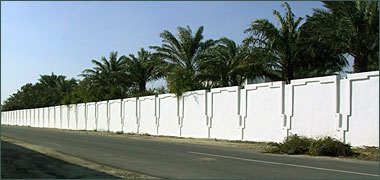
Good security is one of the main design parameters of housing developments in the West. However, not everything that may work there will do so in the Gulf. The essential differences between the layouts I am proposing and those towards which the West is moving, can be seen in the approach to perceived – if not actual – security, together with the development of traditional access from housing out into the wider world. There are other important guiding factors, but I shall deal with those later.
Tradition and change
I have written in the introduction of Islam’s governing the relationships between the individual, family and society; of the responsibilities of that framework, and of the need to understand how religion governs all aspects of life. Traditions are the structure by which we operate and regulate our social life, and the way in which they are established is through our legal systems. Within that understanding there is the idea that tradition has been developed over time – not just as a series of changes to social mores, but as a continuance of the laws governing Muslims and their relationships with each other and, of course, their paramount divine relationship. For it should be evident that, at the outset of Islam, there were a variety of legal and social codes operating, and these had to be organised and amended to conform with the principles set out in the Quran.
The issue of tradition has a central role in the manner in which we all live, or might like to live. It is particularly important in the Muslim world as traditions are heavily enshrined in shari’a, the law which governs Muslims in all their dealings. For a better understanding of this area I suggest those who are interested read the paper by Al Hathloul which deals with the way in which the law changed with time and why tradition is important to us.
The rapid rise and influence of Islam saw the legal framework attempt to embrace and rationalise a variety and number of different systems. By the beginning of the second century AH, there were sufficient difficulties for two schools of law – the Hanafi and Malaki – to develop in Kufah and Medina with the intent of examining the systems with reference to the original principles of conduct established by the Quran. By the second half of the second century AH, a swing towards the primacy of the authority of the Prophet had taken place with the ensuing establishment of importance in the hadith. The early third century AH saw rationalisation of the different approaches by Al-Shaf’i in the force of the sunnah being the divinely inspired behaviour of the Prophet, and buttressed by the theories of ijma’ and qiyas, respectively the principle of consensus, and reasoning by analogy. However, the third century AH saw the work of Al-Shaf’i developed, and its structure amended in emphasis. In particular, ijma’ assured the authority of legal theory, and eliminated the use of independent judgement.
Essentially, and the key point to remember here, is that the development of shari’a established tradition as a guide to the present. In this sense, the development of urban solutions continued based on accepted traditions, albeit ones that developed as resolutions were made on the basis of resolved difficulties.
Security and safety
Security, in the context of housing, is taken to mean the security both of people living in areas of housing, as well as the security of their possessions. However, it must be understood that, in the past security had the specific meaning only of the security of inhabitants against attack by an external force. This gave rise to the main features of buildings: high, smooth walls mainly unrelieved by windows to the outside on the ground floor though, where there were any windows to the outside, these would be barred externally and shuttered internally; strong teak doors mounted on heavy pintle hinges, barred on the inside and having a wooden lock on the outside – this feature being required only to prevent casual attack or to safeguard those inside when the owner of the house was away.
Arab housing has traditionally dealt with many of the security problems now faced in the west through this reflection of social values, and it is regrettable that copying aspects of Western housing should now render the houses more vulnerable to crime and, by the same token, make the inhabitants feel less safe than they would in their traditional neighbourhoods.
It is becoming commonplace in the West that designers should now take into account – and be required to take into account – security measures in the layout and detailing of housing. In the past, and to a very large extent, physical security in areas of Qatari housing was provided by a combination of features which included:
- ambiguity and lack of signing,
- discontinuity of the traffic system,
- the similarity of character in the houses, and the
- secure aspect of walled housing characterised by relatively few openings and high walls.
But, in addition to this, there was the security that came with the:
- limited number and character of objects to steal,
- established character of communities,
- characteristic attitude to crime of an Islamic society, and the
- relative lack of strangers in the neighbourhood.
Because of this – the relatively small size and the self-regulating mechanism of the society – there was also little need for formal law enforcement agencies, the society controlling and dealing with its own problems.
With the character of housing formed by the bonds of the neighbourhood and its closely-bound inhabitants, the stranger was at a particular disadvantage in approaching and entering housing areas though, paradoxically, it must also be noted that there is a strong, traditional requirement for Arabs to be hospitable to strangers. Indeed Hatim Tai, who slaughtered his favourite horse to feed a visitor, embodies this code and the attitude towards hospitality that is still met in Qatar.
The hierarchy of the traditional Arab house together with its surrounds provide for a series of thresholds of security.

In psychological terms the inner element of the house is where the inhabitants feel safest and this area adjoins that in which family guests can be met, the men having no access to the inner area. Outside this there is the semi-public area, commonly the majlis, where those having business can be met in a structured setting and, outside that, the immediate neighbourhood.
There is, outside this another area in which there is a right to access through established territorial ownership by the society but where you are likely to meet more strangers and, to some extent, to be at more risk. But the system was a self-regulating mechanism, developing and responding to process and change with time and circumstance.

In physical terms security can be seen to be provided by concentric rings of protection, the concentric rings being provided by passive, design or construction elements of the building compound and surrounding area.
In this way of thinking, the degree of territorial penetration and ambiguity must be seen to be essential elements of the overall conceptual system of security. The corollary of this is that, where there is little ambiguity and a large degree of territorial penetration, there is likely to be concern for safety and a corresponding requirement for stronger physical protection.
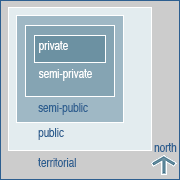
However, a particular characteristic is that the house appears to face the direction from which visitors – and danger – might be expected to come. This also seems to replicate the manner in which tents were pitched, though it’s not as simple as that. In Qatar this coincides with the construction of housing which, in the main, turns its back to the dominant shamal winds that come from the north north-west, as well as the western sun which can be extremely fierce. All other things being equal, Qataris – particularly those with a desert background – appear to prefer to open their houses to the east and south. I should also say that, in well established urban situations, the entrance to houses was not always approached directly but by a flanking movement caused by the narrow width of passageways. The end of the passage – which would be a dead end – would often be set facing down the passage. More of this later.

In establishing the development in this way, it is only minimal elements of the house that are exposed to the worse aspects of the weather, or to potential danger, the latter usually perceived to be raiders of one sort or another. In most developments this would only be the door though in some developments, both rural and urban – and where the majlis is an element of the main compound – the majlis windows would also open to the outside, though not to the inside of the development.
It has always been important that there is a good degree of security, particularly visual security, between any areas where guests or strangers might legally circulate, and areas of the private elements of the house where the women of the household live and circulate. Where there was the threat of real, physical danger, then the developments took particular care to protect all openings in walls. The most common manner in which this was accomplished was by allowing no openings at ground level which could be accessed or forced – other than a strong door and, in the case of a majlis, wrought iron bars and teak shutters fitted with wrought iron or, later, brass bolts.
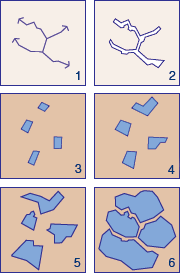
Thumbnails #1 and #2 of the diagram to the right illustrate how the boundary of a neighbourhood is marked by a space normally viewed in a western sense as a street, physically isolating the boundaries of one development or feriq from its neighbour. Thumbnail #1 illustrates an apparent street structure while Thumbnail #2 illustrates the notional space between the enclosing buildings.
In a sense, this might be understood to be left-over space with no ownership, created as small communities coalesced and moved towards each other. I should add here that the ownership of the external space has rights and duties associated with it, but this will be dealt with elsewhere. What is important to understand is that this space is used as a route for access from one area of the town to another, and is read by westerners as a street, though with an eccentric shape considered to give a romantically attractive, perhaps mysterious character to the neighbourhood. Thumbnails #3-6 illustrate this notional growth of development, each element having its own, internal movement system associated with and particular to the owners who have developed this part of the system, usually as an extended family.

Here you can see an illustration of the way housing developed naturally with access paths adjacent to them. This housing was located near to the Wadi Sail on the south edge of Doha, the photograph being taken in 1947. You can see the large site on the right has three main divisions, incorporating palm trees. Adjacent to it other sites are developing. The building structures are generally oriented east-west on the north and west sides of plots, both to protect from the shamal as well as to be available to the onshore breezes common in the mornings.
What is notable is that although the more public areas are residual, they still enjoyed a sense of ownership by those living in the areas immediately adjacent to them and were kept clean and clear. I assume this was because the adjacent owners accepted an implicit responsibility which I don’t believe is replicated much in the West, though it once did until the various communities broke down. As I will note elsewhere, this has also broken down in the Gulf with the establishment of the baladiya and its functions and responsibilities.
Progress and change in the West has brought uncertainty and a perceived increase in crime. The extension of this argument can be seen in the use of Closed Circuit Television (CCTV) systems in our public areas and the desire to amend or design housing layouts ‘to reduce crime’. Considerable effort is now made to have designers of housing estates take advice from the Police and from Planning Authorities with particular regard to ‘designing out crime’. Designers in the United Kingdom, for instance, can now obtain accreditation for their competency in this area with a ‘Secured by Design Accordant’. But this is not necessarily a safe way of designing and, like many design initiatives, will change with experience.
It is interesting to reflect how this is at odds with our own experience of urban areas. We tend to be more engaged in urban areas where there are a considerable number of people – most of them strangers – yet regard them more suspiciously when densities fall. This is mirrored in traditional Arab conurbations where the movement away from the privacy and security of the house increases the possibilities of meeting strangers but locates this in what it considered to be a controlled social environment. The policing of these areas, wherever they are in the Arab conurbation, is maintained not just by those who live or work there, but by every Muslim who, by virtue of his faith, is required to participate. I shall look at this more closely when dealing with socio-cultural issues.
Before leaving this subject I should like to mention a discipline which is increasingly used to determine optimal use from the spaces in and around buildings. Space syntax strives to analyse the manner in which people move and, through intervention in the design or remedial processes, re-direct those movements. On the face of it this is a very useful exercise though in practice it tends to be used to optimise or maximise the interaction of people with activities that are mostly commercial.
It follows that, in re-directing people to increase traffic density, other parts of the system will have their densities reduced – which will create more empty spaces, impact commercial opportunities in those areas and, if the ‘Secured by Design Accordant’ is to be believed, increase the potential for crime. I’m not sure about this nor how this reflects on the way in which Qataris use their pedestrian spaces, but I have the feeling both from talking with them and observing the areas in which they live that, despite their desire for social interaction, they enjoy the use of sikkak both from custom, perceived security and the environmental benefit they bring.
We see buildings as separate artefacts. They order space, fulfilling our requirements in terms of providing for our need to have differentiated spaces in which to carry out a range of social functions. It follows that this ordering of space is really the ordering of social relationships and the distribution of spaces or buildings is the reflection of the society in which they exist. In this respect buildings and the spaces they include, contain and regulate are the means by which we recognise society.
The surveillance and control of external spaces is now considered paramount in order to
- monitor potential risk,
- decrease the incidence of crime through acting as a deterrent, and to
- identify and arrest those creating a public nuisance or participating in criminal activities,
though this mainly obtains in areas other than housing. Having said that there are, in the West, an increase in the construction of gated housing estates with protected boundaries, gate-controlled entrances, CCTV systems and static and patrolling guards. All this points to the many who now feel themselves at risk in their own homes and who wish to withdraw to a state in which they feel safe – whatever that means to them.
To some extent this reflects the breakdown of communities in the West. In many parts of Europe, following the Second World War, this was remarked on as people moved from traditional terraced housing to blocks of flats, often a considerable distance away. Family and neighbourly proximity bonds were stretched or broken. This physical relocation, together with upward mobility, combined to produce different behaviour in those who were transplanted. This movement into new housing was accompanied by a different attitude to ‘ownership’ of their housing. While they took on a proprietorial attitude to their legal and immediate property, they abrogated responsibility for the public elements associated with their housing.
At the same time those who lived in suburban housing began to take an increasing interest in their public spaces becoming, with increasing political awareness, more likely to try to influence not only the treatment and maintenance of public spaces, but the behaviour of neighbours. This has led to the rise of ‘nimbyism’, a well-documented characteristic of communities in many parts of the Western world. Some would argue that this is just a continuation of close community moraes, but one of the interesting points to note is the extent to which incomers – those moving into a specific community – take on active roles in this policing of that community. This characteristic – of identifying strongly with the new community – could be seen in Qatar in a number of ways. One visual clue was with foreigners adapting the Qatari flag to their own, national, colours.
Both urban and suburban areas are now suffering from perceived and actual low-level crime as societal moraes change, reflecting a loosening of individual, family and neighbourhood responsibilities.
Graffiti and tagging
With time and the increase of low-level neighbourhood crime based on changing societal values, there has been a concomitant increase in concern and fear for bad behaviour on the streets in the West. One of the chief elements that the Police use as a factor in assessing problems in neighbourhoods is the appearance of graffiti and, particularly, tagging. The latter’s mention here is important in that it demonstrates local youths marking their territory and, by extension, warning those from outside not to enter it. The Police regard tagging as the first indicator of problems in a neighbourhood and anticipate a rise in assaults, breaking and entering and similar crimes and behaviour. It can also be regarded as reflecting the breakdown in the cohesion of local society, more particularly, the losing of control by families over their children.

I was interested, but saddened, to see that there is some graffiti now appearing in Doha, but not that much tagging. I will write about that elsewhere. The graffiti, as is exemplified by this treatment of a pre-cast concrete panel seems to be low-level, poor quality and mindless in character. This is the kind of graffiti which really antagonises people as it demonstrates wanton destruction of an object in which time and care has been taken with its design and construction. It upsets those who have created the object and it upsets those who see the results. But it is significant that there is a small amount of political graffiti. It’s not possible to say who is responsible for either the tagging or graffiti due to the large number of ex-patriates in Qatar, but I believe it’s a relatively new phenomenon.

Having said that, I recall seeing similar, non-political, graffiti in the seventies and eighties so, perhaps, not much should be read into this in terms of it signifying a rise in crime. Perhaps it’s more an indication of young people having a bit of fun or imitating what they see on television, though it still indicates a loosening of traditional values. Perhaps it’s more to do with the loosening of territorial control through the moving of Qataris to new areas of the state. This graffiti, by the way, is in an old area not a new one. I’ve written more about the subject on one of the society pages.
Informal surveillance
A generation ago, the informal security of housing areas in the West was carried out by normal observation from those living in housing overlooking streets. This was possible even when the front windows of a house tended to be the parlour, a room used for special events, and with the kitchen being located at the back of the house where it acted as the internal focus for the home. This housing pattern, while appearing to militate against the ability to police the street, worked as the
- doorstep was a place for contact and casual conversation with a lot of movement between the inside of the house and the front door,
- the street was used by children in relative safety from the few vehicles on the streets, and
- in a closely-knit community, there was considerable movement between houses.
Much of the community was inter-related with extended families living in the same street or in adjoining streets. It would be rare for families to live far away from each other. Those who were not family would be friends or at least well known to everybody in the area which gave cohesion and strength to these communities.
Because of this, those in the community knew the normal state of their area and would realise immediately if there were strangers in the area, or if anything unusual took place. To some extent they constituted an informal policing of the area.
Visual supervision in Qatar
In Arab urban areas – and, of course, in the desert – this was also true, but to a greater extent, with this characteristic of informal surveillance particularly obtaining. In fact, in the desert, it is traditionally good manners to approach a tent or settlement only from the front and when your presence has been noted. Conversely, anybody approaching by stealth or from an area other than the front of the settlement could be assumed to be unfriendly.
As I have written about below, the pattern of Arabic/Islamic housing emanates from the centre of the home and moves out through the hierarchy:
- private,
- semi-private,
- semi-public, and
- public spaces,
the private, semi-private and, often, the semi-public elements being culs-de-sac. This route system was married to a development of boundary walls that were mostly window-less at ground level, with the exception of majalis and appeared to provide little to promote surveillance from the occupants.
However, three factors enabled surveillance:
- the natural inhibition of those not having business in the area, to move and be seen within it,
- the natural movement of the residents to the mosque throughout the day, combined with their movements to visit public amenities, family and friends, and the fact that
- observation was possible from majalis, first floor windows or mushrabiya, as well as roof tops, with there being a natural inclination to look at or for activities outside.
Bear in mind that this curiosity had much to do with safeguarding both the immediate family’s reputation as well as that of the qabila to which the family belonged and, even, the feriq, the latter often physically coincident with the qabila. In this sense surveillance was both active and passive, an activity that was more important to the society than it was in the West.
Permeability
Returning to the West for a minute, the concern for personal safety is now translating into housing layouts which have increased permeability through them. The crude aim is to move traffic as efficiently as possible through housing areas, and to exclude as many unsupervised routes as possible or, conversely, to provide active and passive supervision of routes.
In order to take routes more directly through residential areas, though, traffic must now be slowed with traffic calming measures, reversing the policy of moving traffic around housing areas in hierarchical traffic structures, and creating new difficulties associated with physical danger to residents from motorists, together with elevated noise and pollution from the use of lower gears, and increased mechanical damage to vehicles when speed humps are used. Perversely, it also brings more strangers through the area.
Of course, it’s not just routes that need to be supervised, but all areas of an individual’s perceived and legal boundaries. Interestingly, this marks a return to the concepts of traditional, house-lined streets which were abandoned by many planners and councils as they moved to culs-de-sac housing developments and hierarchical road structures in order to provide more privacy for an increasingly upwardly mobile society.

The Gulf states are, in respect to car ownership, very much like the United States in that everybody has a car, if not more than one. The cars tend to be larger than those commonly driven in Europe and many households own four-wheel drives. Given the love of camping this translates into an additional need to have high clearance for vehicles, particularly as they are likely to have camping equipment carried on top of them. In addition to this there is a relatively high boat ownership with many boats carried on trailers from the house to be slipped into the sea rather than being kept in a harbour.
At its simplest, the solution I am proposing is for the reintroduction and scaling up of the old, traditional system of housing layouts with one specific addition. Because the scale of housing is now substantially greater than it was due to the size of plot being given to individuals, distances between properties are significantly further than they were. In order to relieve this, as well as to reintroduce something of the character of the traditional layouts, I am proposing a system of culs-de-sac, but linked with pedestrian paths facilitating access between houses without individuals necessarily having to move out onto the more public spaces.
Access to the pedestrian paths will be both from the culs-de-sac as well as from the house plots directly onto the pedestrian paths themselves. This replicates traditional systems, giving additional privacy to pedestrians within the system.
This might be thought to reduce the security of the area but, for the reasons given above, I think not. On the contrary I believe that with the additional activity this is likely to support within the housing layout from those living there, the feeling of security will be enhanced. While it is certainly true that anybody can move into a housing area either on some form of transport or on foot, they will be readily noticed in the culs-de-sac which are the main route into the pedestrian routes.
An example of this layout has been constructed in Doha. From casual observation I believe that it works as I have described and, in that respect, is relatively successful.
One final note and that is it appears that the manner in which we look at pedestrian routes in the West is still not properly understood. Two key finding are that pedestrians tend to underestimate the distances they are prepared to walk, and attractiveness of the route is not as important as we tend to believe. Certainly safety and attractiveness are features we look for, but it appears that minimising time and distance are primary considerations.
Privacy relationships

These two diagrams are intended to illustrate something of the relationship the family has within and outside its house on its plot of land. It is imperative to understand how important this is in the placing and layout of houses as well as the areas leading to and from them.
I have written elsewhere that the planning of urban areas proceeds, in Arabic-Islamic tradition, from the privacy of the inside of the household to the more public, urban areas. This privacy, together with the Islamic tradition of maintaining a private and neutral face to the outside world has, more recently, been compromised by a number of factors. Some of these have to do with the character of those moving into new forms of housing heavily influenced by the West, others are related to the form of plot provided by government and the planning requirements imposed on the plot.

The arguments I am usig may appear to be based on traditional road hierarchies moving down to pedestrian systems, but this is done to make it more familiar to traditional Western planning principles. In reality the designs flow out from the interior of the house and its plot. The essential point to bear in mind is that the external spaces are, in essence, a series of majaalis structured in a hierarchical manner and along which people, usually men, meet and discuss events in an informal manner.
It is not my intention to deal here with the issue of the individual’s attitude to the architectural treatment and decoration of the outside of his house. Much of the attitude to new ‘Islamic’ design revolves around the treatment of the façade which, sadly and to a large extent in housing, appears to involve a competitive attitude. Rather I want to look at the planning of sites and the theoretical design of façades.
Government provision to nationals
The government provided plots for its nationals of two sizes, thirty metres square for Public housing, and thirty-five metres square for Senior Staff housing. Constraints placed upon the design of the plots didn’t allow the main building to be within five metres of the boundary. This creates two problems:
- privacy of the site is compromised by its being easily overlooked by neighbours, and
- the area for location of the building within the plot is extremely limited.
Privacy
Much of these notes relate to the two-dimensional planning of areas with regard to privacy but, as I mentioned above, there are other, serious difficulties created by the manner in which new buildings are generally constructed.
Boundary walls and windows
The practice has developed of constructing buildings with their ground floors four or more steps above their surrounding ground. The reason for this is that Qataris have considerable experience of the problems caused by heavy rainfall, particularly flash flooding. In the desert this is understandable and gives raise to significant areas of land under water, though for relatively short periods of time. The wadi system catches and directs rainfall and, in other parts of Arabia can be extremely dangerous as paths often follow them. With heavy rains the water rises extremely quickly and can catch travellers or campers before they are capable of moving onto higher ground.
This is not a significant problem in Qatar, but the difficulties raised by moving or standing waters are well known and need to be considered. This is particularly true in urbanised areas as the very act of laying out estates alters the natural drainage pattern of the land. As walls or other impediments to drainage patterns are constructed, water – when it comes – ponds and can be a real nuisance. Where houses have been enclosed by perimeter walls there is strong possibility that, were the ground floors to be too low, the houses would suffer inundation. The reason for the ground floors being quite a distance off the grade level outside is, obviously, due to rainfall and flood water, but is complicated by the need to build up the ground surrounding the houses with rawdha or sweet soil. This is required because of the need for a soil that will support planting better than the general soils found where housing is constructed. There isn’t too much rawdha available for housing. In fact there is a prohibition against its transportation, but mixtures and admixtures are necessary to provide a suitable planting medium.
The perimeter walls constructed around houses tend to be in the order of two metres to two metres forty centimetres high. Raising the ground floor made the effective height of the perimeter wall around one metre forty or less in many cases.
Sociology of new housing
From a sociological point of view it should also be borne in mind that many of the residents of these new houses were experiencing this type of house for the first time. Not only were they unfamiliar with living in these modern buildings, but the organisation of the rooms were unfamiliar to them with, perhaps, the exceptions of the kitchen and bathrooms. Having said that, neither the kitchen nor bathrooms were of a sort they were familiar with; the kitchens suited a more Western style of cuisine, it being impossible to cook the larger styles of meal that were required, and the bathrooms were a novelty. I shall write about this in more detail elsewhere.
But, more than this, they were not always sure how to deal with elements of the houses such as the windows. It may be a surprise to Western designers but the concept of interior design and even layout was and, to some extent still is, a problem. Windows certainly admitted light but they also admitted the views from neighbours. Because of this families tended to keep to those rooms that were not overlooked, and it took some time for windows to be covered with curtains or any other device to provide privacy. So the usable space inside the house was felt to be restrictive by the owners who resolved the problem to some extent not just be leaving rooms unoccupied but by living in the central corridor. Commonly families sat on the floor as they always had done, and this gave them more of a sense of privacy. Increased wealth gave the families the ability to purchase furniture, usually in sets, and to decorate the walls and, of course, the windows. This has mostly resolved the issue of seeing from property to property, but only by the addition of a device used for a purpose that was not intended.
Of course, the area of land surrounding each house was also exposed to being seen from adjoining houses and this restricted its use by families. I have argued in a number of different parts of these notes that the design of houses on their plots creates restrictive use to their owners. A more careful view of their original housing needs to be made in order to learn and revise present designs.
Building to plot relationships
Let’s look at the basic geometries associated with different kinds of building on differing shapes of plot. Here are illustrations of a single storey and double storey building on a square plot.

The four diagrams here demonstrate the different relationships of a single storey building representing half the area of the site it is built on. The four diagrams below show similar relationships but with a two-storey building.

What is immediately evident from looking at these two-dimensional diagrams is that with the house in the centre of the site, the
- open areas of the site have less opportunity for useful development,
- peripheral development gives complete privacy through introverted development,
- development across the front of the property gives complete privacy from the street, and
- all non-central developments produce better site flexibility.
While the above are theoretical examples of the relationship of a house on its site, actual practice is governed by the planning requirement that there should be a five metre strip inside the property wall in which no building is permitted other than certain single storey development such as garaging.
Plot shape
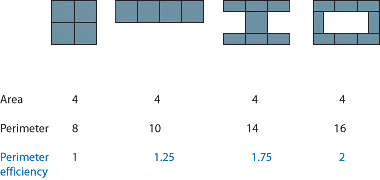
The second issue worth considering is the shape of the plot itself as the ratio of wall to floorplate – the footprint of the building on its site – has ramifications both for cost as well as solar loads on the shell of the building. A circle has the most efficient perimeter to floorplate ratio, with a square the more sensible proposition due to the difficulty of use of a circular building. A study by Gardiner and Theobald noted that plans tending towards a square, without articulation of the footprint line, will tend to be more efficient.

They also noted that buildings with a large floorplate will tend to have more efficient wall-to-floor ratios than smaller ones of the same height. This is a simple reflection of the geometry involved. Whether this is an important factor in Gulf layouts is dubious due to the funds being expended. But whether this is a factor for consideration or not may relate to the increasing concern there is to produce buildings which are more cost effective in running and maintenance. It is a truism that significantly more funds may be expended in the life of a building than were on the cost of its construction.
Location of buildings within the building plot

With regard to the location of residential buildings within a site, my preference is for them to be constructed on the boundary of the site, either along the front or on one of the two sides as is illustrated on this working sketch. This was a traditional way of building in the past, though there has been concern by individuals claiming it not to be secure. There might be thought to be two disadvantages to this as:
- in developing new buildings Qataris have been reluctant to build on common boundaries, stating a concern for security, and
- the possibilities for cross-ventilation may be reduced.
The issue of security seems to be both for views into their site as well as for concern at people climbing into their property. In discussions with Qatari families this was never properly defined. It is my belief that building on the boundary is as secure, if not more so, than building in the centre of a site.
Cross ventilation is also a concern but again I believe there are ways of dealing with this under the variety of conditions that would obtain when building on boundaries.

It is my belief that both these issues can be dealt with relatively easily through education and minimal legislation, and that the benefits significantly outweigh any perceived difficulties. Bear in mind that the government is responsible for setting out and granting assistance in the layout of much of the housing in the country. If this is so, then there will be a significant improvement in the living conditions for those living in and around their buildings. There should be no difficulty in moving these arguments forward as it can be demonstrated from buildings that have been expanded – albeit illegally – that there are benefits accruing to the owners of buildings in terms of the additional use and enjoyment that may be made of their site. Assuming privacy and security are dealt with, the chief difficulty remaining for a building with significantly long proportions, is likely to be that of solar loading and, perhaps, party wall issues though this latter issue would be dealt with by constructing a separate wall for each house rather than using a single wall for both houses as is common in many parts of the world.
Orientation
There has been some discussion about this subject on the environmental control page, but the subject warrants developing here. Generally it has been advantageous to locate buildings with their long access oriented approximately east-west. Studies carried out on the Masdar project in Abu Dhabi has suggested that the orientation should better approximate north-east to south-west. This should ensure minimal solar loading and also suggests that buildings should have proportions favouring a rectangular over a square plan. The principle, followed slavishly, would mean that all buildings would end up parallel with each other – assuming that the road system runs in a grid or orthogonal system. In Qatar, this has been the usual case for many of the new housing areas. There are also a number of layouts which are oriented approximately east north-east to west south-west, the latter being the direction of Mecca from Qatar and which are nearer the Masdar orientation.
But it is not just the sun which has to be considered in dealing with optimal orientation; air movement and humidity also play a part in these considerations. In addition to the theoretical conditions created by these natural phenomena, there is also the need to understand the micro-climatic effects that will apply to the building or buildings.
I have linked air movement and humidity together though it may seem intuitive that wind direction is the more likely component relating to building direction. The reason for the linking is that, in littoral conditions, on-shore and off-shore air movements are associated with humidity, and traditional buildings in Qatar took advantage of that in their orientation.
Effects of micro-climate
The micro-climate will be created by a combination of the solar and air-movement factors – both of which change throughout the day – together with their effect on surrounding volumes and surfaces and the influence of other agents. Generally these will include but may not be limited to:
- air turbulence created by air movement around adjacent natural planting and man-made structures,
- the addition of natural phenomena such as sand and dust,
- air flow in and around the building itself created by the disposition of the elements of the building on its site together with its landscaping,
- the density and character of adjacent landscaping,
- specular reflection from adjacent buildings and structures, both direct and indirect,
- adjacent or on-site sources which reduce or add to humidity such as ornamental fountains, sprinkler systems, air-conditioning exhausts and swimming pools,
- any commercial or industrial activities which have an immediate environmental impact, and
- the degree of urbanisation.
As I suggested above, there is a strong presumption that buildings should be oriented approximately on an east-west axis. But factors such as prevailing wind direction, which suggests that buildings should be oriented normal to the wind direction – in Qatar this would place them on an east north-east to west south-west axis – may be separated and resolved regardless of the solar orientation preference. If the purpose of paying attention to wind direction is to facilitate natural ventilation within a building, this might be accomplished with devices which are oriented differently from the building.
It might be argued that artificial air-conditioning takes away the need to consider orientation, but one of the purposes of these notes is to encourage designers to reduce their clients’ reliance on artificial means of climate control.
Traditionally, Islamic architecture has shown significant awareness of the effects of micro-climates and has responded in a number of ways to ameliorate environmental conditions both inside and outside buildings. The use of water to bring humidity into buildings in dry areas saw the introduction of water in both pools and fountains, there being an additional benefit to building inhabitants from the sound and sparkle of the latter.
Outside buildings narrow sikkak developed which, while providing some degree of securit,y had considerable benefit from the provision of shade to those moving around conurbations in hot weather. Within these sikkak micro-climates developed providing a resource of cool air as well as channelling air along them and into buildings which had open grilles, commonly above entrance doors and windows, to receive this source of coolness.
more to be written…
Design for privacy
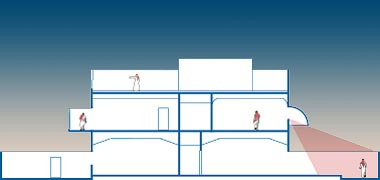
Here are four notional arrangements that would prevent those living in a centrally located house on a plot from seeing into their neighbour’s properties. I have included a solution incorporating a mushrabiya though they are generally designed to provide privacy to those within the house rather than protecting the residents from overseeing their neighbours. Having said that, mushrabiya can be designed to bring light and air into buildings without compromising the privacy of neighbours. This is effected by designing the mushrabiya as louvres rather than in the traditional manner – being constructed from turned wood or, more usually, concrete blocks.
The four types of solution to prevent overlooking neighbours that I have illustrated here are by:
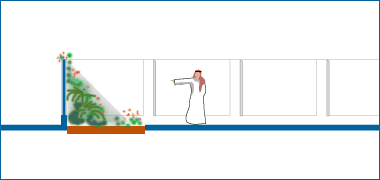
- ensuring that the boundary wall is a minimum of two metres high with respect to at least the finished ground level of the adjacent gardens and, preferably, to the finished floor level of the internal ground floor of the property. If the site slopes then consideration would need to be given to ensure the relative sight lines into adjacent properties would be still be protected;

- also making sure that the roof parapet is at least two metres high and, advisedly, uses a device such as the traditional horizontal badgheer to provide ventilation over the roof’s surface, helping to cool the surface and making the roof space a more comfortable place to use;

- taking advantage of balconies above ground floor level to provide an extension to internal living spaces and, again, maintaining privacy by making them high enough to inhibit their being looked over or, in this case, incorporating a louvred mushrabiya to provide light and air circulation, and

- providing devices to windows above ground floor level that will bring light and air into internal spaces while inhibiting views out that would breach privacy. I have shown this particular device as a horizontally located element, but it would work equally well vertically mounted, perhaps to direct views where there is no privacy problem.
There is another range of solutions that depend upon keeping residents away from positions that would enable them to see into their neighbours’ properties.
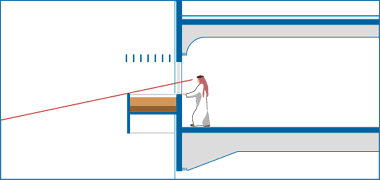
- These would include elements such as planters that have the added advantage of introducing colour, movement and smells to the interiors as well as a degree of particulate filtering. Here I’ve illustrated a horizontal, louvred sun shield that would be designed to protect the windows while allowing limited protection to small scale planting.

- This plan and section illustrate another way of dealing with the design feature suggested in the illustration above – that is to have a screen wall blocking straight views into the neighbouring property, but allowing side views where there would be no breach of privacy. These would have to be worked out on an individual basis in order to provide the necessary privacy in the case of each opening.
Of course it is always possible that an individual can breach privacy deliberately or, perhaps, during operations on their property such as maintenance to its external finishes or utilities. These cases can not be legislated against and are adequately dealt with by Islamic codes discussed on the Islamic urban design pages.
Road hierarchy
Let me go back a little way and look at the framework for planning in which this new feriq was developed. It is worth reminding ourselves that a generation or so ago the concept of a road system was a novelty. Traditionally, sikkak provided access within urban environments and, linking the settlements, a series of routes wound their way across and around the peninsula. The sikkak were mainly designed for pack animals to distribute goods within the urban environment, as well as facilitating pedestrian access. With the increase in vehicle ownership and use the routes became paved and enlarged, but still followed the existing road systems. Selective demolition and construction outside existing urban development enabled a more systematic approach to hierarchical road design, but it was only in the nineteen seventies that finances and political will permitted the development of a more rational road distribution system.
One important point to make is that the road systems introduced from the West were essentially vehicular systems. But they were imposed on a traditional organisation that was essentially pedestrian or reliant upon pack animals – camels and donkeys – and wheeled carts. Moreover the sikkak were essentially accidental, as they were routed around the houses that were developed along traditional rules governed by Islamic jurisprudence. Certainly vehicles were introduced prior to the Second World War, but they were a rarity and unaffordable by many of the population. This conflation of pedestrian and vehicular systems has caused significant problems in establishing patterns that suit both the national and expatriate communities. As an aside it is also worth mentioning that the new road systems did not take account of wither the considerable increase in private vehicle ownership, nor the considerable construction traffic created by the heavy pace of development. In fact there are a number of other issues that the calculations seem not to have taken into account, but I should look at that elsewhere.

The demolition of the centre of Doha, together with the construction of residential areas outside the centre, eased the introduction of a hierarchical road system. The laying out of the system generally, and one that was reflected in the design of residential areas, was based on a structured Western approach to vehicle movement. This replicated what was happening in Britain, particularly, in the early seventies. The principles were clear: primary distributors took vehicles along fast roads from which secondary distributors moved into areas approximately a kilometre square, and from which local distributors brought access to houses. Remember that this is a vehicular system and takes no account of pedestrians. Note, in particular, that this is the way in which the road system was considered in the West: the large scale roads stepping down in scale to the small access systems associated with housing.
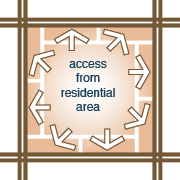
Within this framework there is a pedestrian network permitting those who live in the district to move between areas as well as to the primary roads in order to link with public transport systems and taxis. What was needed was a system which combined ease of access with privacy and security. I have written elsewhere about the Western approach to security, with its move away from culs-de-sac, the increase in gated communities and the effort to reduce access for those having no lawful business in an area. In Qatar the districts are well policed in the sense that there are always people around watching to see what is happening. Some of these will be watchmen employed by households, and many households have other staff looking out for their employers one way or another. Of course, the nationals have their own traditions of informal surveillance, much of it due to the large amounts of movement – by vehicle and pedestrian – there is between houses, as well as to and from the local mosque. The pedestrian system within the primary road structure allows considerable percolation for pedestrians, and this helps them move towards both the primary and secondary road systems where they can catch taxis. This approach differs considerably from the Western approach, but it appears to work and, in permitting a high level of freedom of passage, accurately replicates traditional systems.
The design and provision of sikkak needs to be carefully considered. In today’s society the needs are slightly different from those previously a part of the urban environment. The interconnection between houses is still important, as is access to the local retail units, wherever they are located, and to the primary or secondary roads for access to taxis and public transport systems. Generally speaking, the new sikkak are too wide, a problem caused by errors of drafting or surveying, misunderstandings of their rationale or, in my experience, both.
Local distributors

At the same time as the designs for culs-de-sac were being developed conceptually, the structural system and character of the local roads or distributors were also being considered. There were seen to be a number of ways in which the distributors might be designed, but it was thought important that they should not just follow the Western models blindly. Driving safely is important, and while it is not possible for planners to train drivers, a road system that is easy to navigate is an imperative to develop safety in residential areas. This was taken to mean that
- speeding should be discouraged,
- junctions should be safe with good sight lines to oncoming traffic,
- no planting should mask traffic,
- there should be no cross junctions, and
- the layout should present an attractive, if not unique, character.
Essentially, the concept was seen as providing a pleasant place in which to drive, and not one that drivers would wish to drive through quickly. A number of notional schemes were looked at with a view to providing at least the above. Some of the schemes were unrealistic in varying degrees, one of them being that illustrated here, but it may be instructive, hence its inclusion. There were three main reasons why none of the schemes investigated were constructed. Some of them might still be valid today but, at its simplest the reasons were that,
- in those days it was seen to be essential to place as many housing units on the site as possible,
- the government organisation responsible for constructing roads were not as flexible as it might have been,
- the notion of roads running in anything other than in straight lines was considered, at best, eccentric, and
- its being thought unlikely that the landscaped areas would ever be planted.

In the example above the junctions were designed to stop traffic speeding through them. Additionally they were over-designed with the intent that each would have an individual landscaped character to assist in way-finding. This was buttressed conceptually by the area between cul-de-sac housing blocks being seen as a continuous landscaped park, while each area between roundabouts would also vary in character giving those houses fronting onto the main road a softened character to compensate for their not being within a landscaped cul-de-sac. While this was seen to be problematic at the time, it is now recognised that there are ways of dealing with this problem without the expenditure of massive amounts of water.

Here there is a notional way of looking at the concept of the landscaped parks associated with the housing fronting onto the local distributors. In this first illustration, no great effort has been taken to design the space as an urban setting with a character of its own. The implication is that the space belongs to the road and parking system, and that there is very little benefit to be obtained by those living and fronting onto it. Despite this the sketch shows relatively heavy planting of small trees such as casuarina, set back from the road.
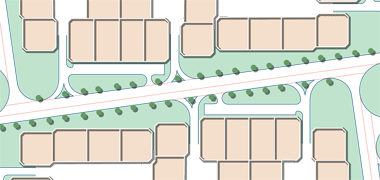
But the type of planting shown in the preceding paragraph would be unusual in Qatar, particularly at the time that these exercises were being carried out, in the early 1970s. Landscaping was a Municipality function and the manner in which it was carried out was as an adjunct to the roads. In those days there seemed to be only three types of tree planted beside or on the medians of roads, and they were ficus nitida, washingtoniaand felix dactylifera, the date palm. On roads such as these relatively unimportant distributors, planting would more likely be as illustrated here, the design focus being on lining the roads, reinforcing their importance.
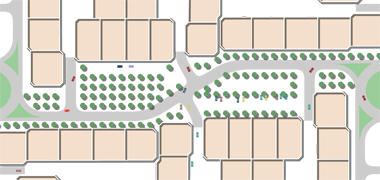
This illustration shows how the principles relating to the creation of recognisable urban spaces belonging to those living facing them, rather than in the culs-de-sac, might be better carried out. Firstly, additional house plots have been created to help enclose the urban space. Secondly, the urban space is seen as being covered in a material that is essentially paved but which has a route for vehicles marked out in a differing material, or by the placing of plants, planters and the like. Thirdly, there is more emphasis in slowing vehicles moving through the urban space and, fourthly, the spaces in front of the plots facing onto the distributors is designed to relate to them in a similar way to which the culs-de-sac are designed.
Bear in mind that these were just design studies, and that there are many eccentricities incorporated within them that would have to be resolved. But the principles of
- slowing traffic,
- focussing housing plots on related semi-public spaces, and
- incorporating structured planting related to housing and not roads
were considered to be essential design parameters in the development of residential areas such as these. While the sketch above indicates roads in grey, there is no reason why they have to be delineated as such but might be continuous paving, for instance, provided that the routes to the culs-de-sac and housing frontages are evident.
There is an additional benefit as is illustrated in this sketch. By cranking the road and allowing two distinct urban spaces to develop, there is the opportunity to introduce obvious design elements that support the local communities. A masjid and a small retail facility are obvious candidates, as would be facilities relating to children or external majaalis.

There is an additional benefit as is illustrated in this sketch. By cranking the road and allowing two distinct urban spaces to develop, there is the opportunity to introduce obvious design elements that support the local communities. A masjid and a small retail facility are obvious candidates, as would be facilities relating to children or external majaalis. This sketch illustrates the two most obvious possible alternative locations for masaajid associated with the local distributor. These are also possible locations for dukaakeen, while elements such as external majaalis and recreational facilities might be located in many places within the area.
Landscaping principles

At this stage it also worth mentioning the planting system suggested to buttress the development, creating identity and softening the man-made developments. The principles suggested here were for there to be formal, structured planting along primary routes with low density planting between the primary routes and residential areas, building up to high density planting within the residential areas. This system would be reinforced by plant type selection to create a significant degree of identity within the different areas of the city.
In addition to these scales or densities of landscaping there would be additional planting associated both with the sikkak as well as with a series of small parks that would be located within the residential areas for the benefit of the residents. It was envisaged that they would be used by children and, hopefully, women of the area as they would feel safe within their local neighbourhood. Selection of the species would ensure they were suited both to the needs of the sikkak as well as to the parks.
The sikkak needs are for shade, colour, movement and smell. The needs of the small parks are slightly different with the requirements of each park being considered separately in order to reflect the possibility for more robust planting taking account of anticipated play and recreational behaviour.
Relationship between urban development and desert
Developing this vehicular and pedestrian system for local use suggested that the link with the desert was crucial both actually as well as psychologically. Because of this it is necessary to pull the road system apart, permitting the desert to move through the system between residential development. In effect, separating each new feriq by a continuous strip of wildscape – to distinguish the natural desert from the artificially planted and landscaped areas.

The two illustrations above show the intent of permitting the desert to filter between the urban, residential areas, permitting views from their entrances and giving a reminder of the history of the State. The formal, primary routes crossing it will contrast with it, and the residential areas are marked by features individual to each area. One possible feature here would be a mosque, permitting travellers to take advantage of them as well as for those in the residential areas to walk or ride to them. This would be in addition to mosques within the residential areas.

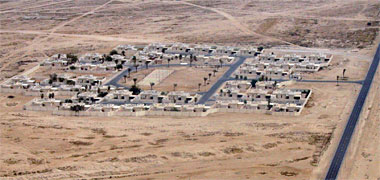
Here is a relatively small example of the above theory in practice. Situated north of al-Wakra, and under the approach to Doha’s international airport to its north, this residential compound may not be located in the best position for its residents’ comfort, but location decisions are often taken on other variables such as land ownership or proximity to work area, so this is not unusual. Whether the planners should allow this is another matter.
But there are other issues. The development’s outline is also extremely irregular, a feature which will exacerbate problems related to cleanliness outside the compound as well as security. The re-entrants in the north-east and north-west corners of the compound are particularly poorly considered from this point of view are likely to encourage the dumping of rubbish and the establishment of unofficial or seasonal housing or storage. None of this will be to the benefit of the residents. Incidentally, the main road running in front of this compound is aligned more or less on an east-west axis.
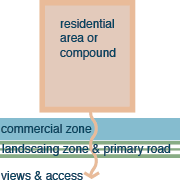
Commercial areas would also be suitable in this location. It is quite intentional that the relationship of the residential, commercial and primary circulation access replicates the traditional arrangements of settlements. This is as valid today as it was in the past. I have written elsewhere about the unusual patterns of development, the high relationship of retail and office space to population numbers and issues relating to sustainability. It will take a long time for this to be recognised and, hopefully, lowered and this structure will reflect the dispersed patterns of land use now being promoted in the West as a direct result of improved communications. With respect to the housing photographed above, my feeling is that it should be set back further from the main road.
Aggregation of culs-de-sac
So, bearing this framework in mind, let me return to the cul-de-sac to deal with the way in which it was developed, and elaborate on how the new feriq was created.
Described above is the basic cul-de-sac. Three features are imperative for its proper functioning:
- the need to give it a sense of enclosure by narrowing the entrance visually,
- sizing it such that backing movements are generally unnecessary, and
- enabling pedestrian movement through the closed end of the cul-de-sac.

The diagram of the nine plots shown here illustrates a basic unit for development. Three, five and seven units are possible, but nine appeared to be the optimal size for creating useful culs-de-sac in which a variety of activities and safety considerations could be sensibly located. Subsequent Municipality requirements for the location of refuse facilities suggests that the basic layout must also accommodate this.

One useful way in which this type of layout can be developed is with the provision of housing which fronts onto the access road. This is a popular way of creating more visible houses with the advantage of having a large area of planting in front of them.
It would have been even better, as I have argued elsewhere, if the frontages were narrower giving either a denser population to the cul-de-sac or a shorter cul-de-sac with the same population. Talking with members of the qabila it was obvious that the denser frontage is very much preferred – whether or not there are frontage-located properties or not. There appear to be two reasons for this:
- a genuine preference for loose density, particularly in qabilat having close links with the desert, and
- the knowledge, or hope, that they would be able to develop additional accommodation on their site.
In fact, planning regulations make this latter relatively unlikely, other than for small developments such as turning a garage into a store. Even this is not always permitted.
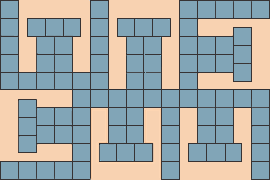
One of the difficulties encountered in the development of the houses was the extreme reluctance for anybody to accept less than the thirty metres square plot they were given. Although it was eventually accepted that the thirty metres could be centre to centre of a single 200mm block party wall, nobody would at first agree to a splay being taken from their site in order to:
- ease the movement of pedestrians round corners,
- produce improved sight lines for vehicles moving out of culs-de-sac, and
- create areas for rest and recreation.

Incidentally, while working up the layout it’s normal to make a number of exploratory studies which illustrate some of the principles used. This partial sketch is taken from one of a number illustrating the use of the pedestrian system for utilities; the raking of property corners to ease movement round them; the use of junctions as meeting places; some form of shading over the pedestrian routes, and their relative narrowness for optimal climate control. Sketches such as this are useful in understanding how elements of the project – both physical and socio-cultural – might come together. Bear in mind that this sketch does not illustrate a solution, only certain principles under consideration.
Developing the layout

Looking at the basic geometry of the layouts above you can see that they do not allow for pedestrian paths to move people through the site. In order to provide access through the site the plots have to be teased apart. The simplest way to do this is to provide pedestrian routes within and through the site based on a 2.20 metres wide path, measured centre to centre of 200mm block walls. The actual width of two metres is notional and perhaps could be argued as being 3.20 metres, as was traditional. But this was related to the need for two pack animals to pass and, with relatively low volumes of pedestrian traffic – as well as relatively low boundary walls – the paths really need to be narrower to provide some degree of solar protection. In addition to this, of course, is the need to keep vehicles out of them.

The above diagram illustrates the manner in which all culs-de-sac are connected, as well as how access to the public areas outside the culs-de-sac is effected. As illustrated to the side here, it would be possible to make further pedestrian routes between adjacent culs-de-sac, but the additional permeability might be counter-productive. Further, it might be considered that the pedestrian routes nearest to the entrance to the culs-de-sac might present danger to children moving out of them into the paths of vehicles entering the culs-de-sac.
However, it can be seen that splays have been made on a number of plots, but with no compensation in area to the owners of the plot. On a lot with a single splay, 2 sq.m. are ‘lost’ and, for those with two splays, 4 sq.m. are ‘lost’ – from a total lot of 900 sq.m. It is, of course, possible to calculate and compensate for these ‘losses’, the difficulty being that it makes the setting out more complicated.
The reason I have included these calculations is that there was significant resistance by people thinking they were losing a significant amount of land by having a corner splayed. The calculations helped ease their minds but there was still resistance with the feeling that the splayed corner would somehow make things more difficult for them.
One reason this was not carried out was that, on the layout actually built, significant errors were made in laying out the site, rendering the concept of calculating area compensations academic. These errors were far greater than those noted above and below for compensation but, in the event, it is evident that the relationships and location of sites were more important than their accurate sizing.
Dimensions

This first diagram illustrates the layout of a theoretical cluster of housing plots, each thirty metres square, centre to centre of 200mm block walls. The splayed corners, together with the off-set walls, also fulfil two other important functions: the first eases movement around corners for pedestrians using the system, and the second ensures that it is not possible to see from one end of the site to the other, creating more privacy and a sense of security.
Because of the latter, perspective sight lines are only a few plots long and give a greater feeling of security to those living in and using the site. This is very much in the spirit of the original housing in the centre of Doha where the occupants had more of a sense of safety; for the visitor a sense of mystery. The main difference, of course, is that the plots are still large and the lengths of wall long compared with the old developments. There is no easy solution to this if the shapes of the sites are to be kept simple and the walls unarticulated.
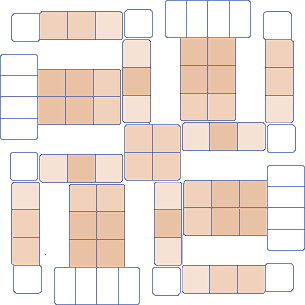
A number of different versions of the basic layout principle were examined with regard to variation and shape, these two sketches representing some of them. The first sketch varies in that there are a small number of sites that have every corner splayed. In theory the area nominally lost would be compensated for by increasing the basic size of those lots to have them the same area as the more regular lots. In fact, this principle would apply to all sites. But it also introduced sets of four lots facing the local distributor roads. This has both advantages and disadvantages. Some potential residents felt that there would be more prestige attached to facing onto a road, and this would be a preferable position for those with that perspective. In fact, this thinking followed the existing layouts where everybody faced onto a local distributor.

But it was also felt that the people living outside a cul-de-sac did not have the same degree of social inclusion that the cul-de-sac provided, and so those on the outside might have different shaped plots which they might find more acceptable as a trade-off. In the diagram associated with the preceding paragraph, the three lots of the first diagram have been changed to four lots that are longer and narrower than the square lots of the main part of the site. In the second diagram the layout shows the three sites facing the road, and has been loosened slightly with additional sikkak which were introduced because some potential residents asked for there to be more connection between culs-de-sac in order to be able to link with members of their wider families. It is difficult to comment on this aspect as Western planning tends to dislike this arguing that it makes layouts less secure. Oddly enough, conversation with potential residents seemed to equate the sikkak with improved security.

If the thirty metre square plots – the standard size given to Intermediate staff – are scaled up to thirty-five metre square plots – the size of plot given to Senior staff – then it would be possible to make small adjustments to the layout in order to give staff exactly the same areas of plot. This has been a much greater issue than was at first envisaged, and more work must be carried out in order to ensure that each owner gets the same amount of land.
At its simplest, sites with a single splayed corner would have to be increased in one direction by six centimetres and, for the two splayed corner plots, by twelve centimetres in order to bring them both up to approximately 1,225 square metres, the equivalent of the thirty-five metres plot without splays. This diagram illustrates a simple arrangement, but it could be improved upon. Bear in mind that this is still only a theoretical example and would have to be amended in some detail to accommodate an actual layout. I should have also mentioned at the outset that because Qatar is so relatively flat, modulation of layouts to accommodate contoured land has never been an issue, and layouts tend to be orthogonal.


These first two illustrations are intended to give an indication of the basic massing of the plan that’s shown above. The massing has assumed a two storey building height of 10.5 metres, and a footprint of 17.00 metres a side for each building. No ancillary buildings are shown though on every site there would be garaging, storage, a gatehouse and, perhaps, an area for animals or birds. A boundary majlis is also a possibility. The 1.80 metre clear width pedestrian sikkak at the head of the cul-de-sac can be readily seen. No attempt has been made to bring interest or variety to the housing; the sketches are solely there to give a first indication of massing. They are, of course, shown as aerial perspectives, a view that only architects, planners and some clients will ever see. Urban design is experienced from the ground.

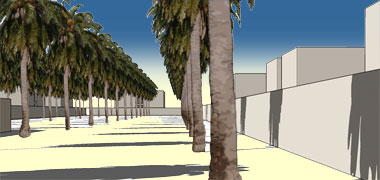

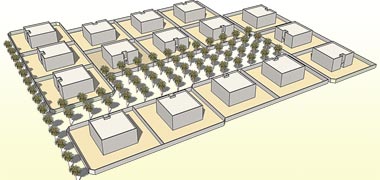
This notional view is taken from the entrance to the cul-de-sac and looks over an empty space. While not giving a real idea of the scale of the cul-de-sac it does give an indication of the relatively low density provided by the eight houses fronting onto the cul-de-sac. The house at the far end of the cul-de-sac facing those entering the cul-de-sac would be considered the most important building there; those at the entrance to the cul-de-sac the least important. Whether this would reflect reality is debatable as individual design can modify a house design considerably. However, it is true that the house at the end will have a significant advantage in being the focus for those entering the cul-de-sac, and this was my experience dealing with a family moving into new housing using the cul-de-sac principle of housing disposition.
The middle two sketches give a crude illustration of how the cul-de-sac might appear with high-canopied date palms planted regularly through the cul-de-sac. The first illustration is taken from the entrance, the second from within the cul-de-sac. The aim would be to produce something of the feeling of a date farm though there would be more space around the foot of the tree required for watering if the traditional system were utilised. Notice that the introduction of this type of planting throws the end house off the focus of the entry road in the top of the two illustrations as the road system is assumed to be peripheral, but that it would be the focus of the internal space. The final aerial sketch illustrates the regular planting of the palm trees, suggesting that they might be extended out to the local distributor where they might become peripheral planting to the road.
One final consideration for this character of planting is that the cul-de-sac might not be laid out for roads and parking as is usual. It might be that, with the low density of vehicles within the cul-de-sac, vehicles might move where they wish, and that only areas for a majlis and children’s play might be established and safeguarded.
The design of culs-de-sac
Three principal factors govern the size and shape of a cul-de-sac:
- the size of the plots that go to make up the residential area,
- the optimum number of residential plots which would make up a cul-de-sac grouping, and
- the optimal size of the public area based on the functions it has to provide and support.
The most important of these latter functions from a safety point of view are the turning circles of vehicles, particularly service vehicles of which the largest are those collecting refuse. It is important that all vehicles should be able to turn safely and that backing should be both unnecessary and discouraged.
In addition to this there should be as little conflict between pedestrians and vehicles as possible. As the cul-de-sac is intended to be pedestrian oriented, it is essential that vehicles are controlled in their speed and direction by suitable design and devices.

With regard to the number of families that would make up a cul-de-sac grouping, I have no evidence for an optimum arrangement. Tradition does not provide a solution because, as I have noted elsewhere, groupings came about through family associations, essentially through providing for an extended family. Where space became an issue then the available space was sub-divided rather than found outside the original compound. However, from observation and discussion with Qataris it was evident that from four to eight would be a sensible number, bearing in mind that the plot at the head of the cul-de-sac, automatically has precedence over the others and is assumed to be the house of the person with seniority in that part of the qabila or grouping of the society. Because of this there is an argument that this plot should be physically larger.
Provision for refuse and its collection

Possibly the most unattractive element of culs-de-sac – in fact any area of housing in Qatar and elsewhere in the world – is the provision of Municipality refuse bins. The original concept was that the bins would be located within the curtilage of each owner’s property. This has not proved popular as, particularly in summer, the bins smell and are unsightly. For this reason they are generally placed outside the properties where they are highly visible.


The difficulty with locating refuse bins in public areas is that nobody wants to have them anywhere near their property due to the state in which they are kept and the visual and olfactory problems associated with them. The two locations suggested above are not ‘owned’ by anybody, though both of them have drawbacks. That on the entrance to the cul-de-sac is likely to cause temporary blockage as Municipal vehicles empty and replace the bins, and that inside the cul-de-sac both cuts down the frontage of the adjacent property as well as down-grading that site aesthetically. The geometry of the suggestion also is poor as any acute angle creates cleanliness problems, particularly in an area given over to refuse. This all points to solutions either built into individual properties or stand-alone systems, both of which introduce problems, particularly relating to nuisance and status.


Probably the best way to deal with the problem of their location would be to provide a bin location within the boundary wall of every residence. Exactly where this would be in relation to the site entrances is, of course, debatable, but there is a good argument for having them near the vehicular or service entrances which, at the same time, would be a good place for a utility site entrance and their metering. Here I’ve also shown the front wall returned at the service access gate in order to give some degree of privacy, and I’ve also shown an articulated front wall which has the twin advantages of providing structural stability as well as enlivening the front of the property with planting.
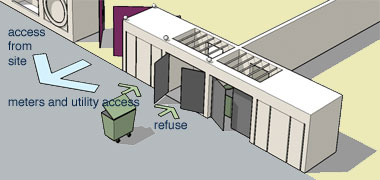
This pair of sketches illustrate a refuse storage area large enough to contain two Municipality refuse containers. It would need to be open to the sky and have through ventilation. Access by the Municipality would be from the outside and a secure door on the inside of the property would provide access for owners. Ideally, they would be grouped in order to assist the Municipality’s collection operation.
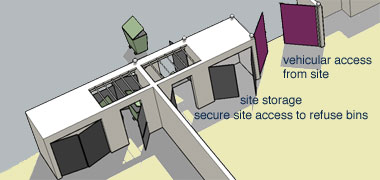
Adjacent to it would be the utility access point with all necessary metering on the outside of the property and, on the inside, a sensible place for storage relating to the garden and site generally. A wash-down point would be located here in order to keep the refuse area clean. This area, adjacent to the vehicular access point, is often the location for a security guard. If this is the case then this part of the site would need to be re-designed to accommodate the three requirements of refuse collection, metering and security.
Having talked about the provision for refuse bins I should mention the possibility of the eventual requirement for a system that re-cycles the materials thrown out. In most countries where re-cycling is established there are systems requiring owners to place their refuse in different bins for collection and re-cycling by the Municipality or their contractors. The space I have suggested for refuse is large enough to accept half a dozen containers but, at some time in the future, the State should begin such a process and make decisions on the way it will collect – and the way in which house owners will be required to filter and store their rubbish.
Visual aspects of the cul-de-sac
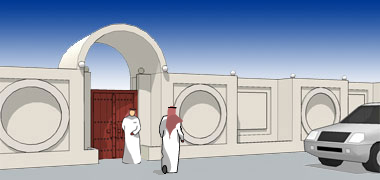
To many modern owners, the entrance to their property is the most important factor for them to consider – apart, of course, from the design of the house. But, as I have argued elsewhere, Islam really requires a much more collective view of property, particularly from the point of view of not embarrassing your neighbours. Even if there is now a certain amount of competitive design in housing, the cul-de-sac can bind neighbours together.
From a visual point of view the spaces are likely to be quite wide as the proportions of width to wall height - or even building height - will be poor if an enclosing urban effect is sought. However, it is unlikely that the effect of an urban setting would be desired by the house owners. Not only do they have still have strong links to the open space of the desert or the sea, but there is a general wish to have an isolated residence or residential complex separated from others both by distance as well as by a security system to give notional degrees of security and privacy and, perhaps by extension, status.
To do this it is not only necessary to have a coherent design for the cul-de-sac but to organise the entrances, servicing points and so on in a distinct manner. This is dealt with later but here I’d like to mention the notion of spatial comfort that the cul-de-sac might have. Many Qatari have a strong feeling for what is comfortable in terms of the spaces they move around. They tend to be uncomfortable with low ceilings and like to have long distance in view rather than being constrained by relatively close walls. This must have something to do with badu ancestry. Moreover, I believe this is also true for those with a marine history.
Militating against this there is also a strong requirement for security. To some extent this is a notional issue but it obviously preys on their minds as it is one of the first requirements made when discussing housing.
A typical thirty-five metre wide cul-de-sac is likely to create the spatial setting at the front of the house that an owner might want, though there can be some dilution of privacy due, generally, to the height of front wall – assuming it to be solid – as well as the adjacent buildings and their design character.
Boundary walls would need to be raised by a considerable amount, say from two to six metres, if absolute privacy were to be assured to residents from the possibility of casual viewing from public spaces. This privacy was, in effect, a characteristic of tighter, traditional development though, admittedly, the conditions and building responses were dissimilar. Nowadays, in modern villas, the knowledge that people can be seen inside their houses through their windows, tends to create a psychological burden on residents, and demonstrates one of the problems facing designers.
The effect caused by this problem is even worse between adjacent properties due to
- their being relatively close together,
- the party wall generally being two metres high, and the
- ground floor of housing usually raised some way above garden or grade level due to the concern Qataris have always had for the flooding caused by the heavy rains that occasionally fall.
Drains block and it is certainly possible for gardens to flood in the winter months. The first public houses to be constructed usually had ground floors a metre above the unfinished garden level.
This simple diagram illustrates the fact that not only is there the possibility of overlooking from the ground floor of the interior of a house but, obviously, from the first floor. I have shown the roofs with only a nominal balustrade. In reality these tend to be higher but really need to be at least two metres high in order to prevent anybody looking from the roof into their neighbour’s garden. I have written more on the legal side of this problem on the Islamic urban design page.
There are evident trends in modern housing for the house to be seen by those outside, reflecting status in the community. It is argued elsewhere that this is not a traditional tendency and, in fact, runs counter to Islamic thinking. Whether it comes from the desire of an owner to have a building that demonstrates standing or worth in the community or whether it comes from the desire of architects to make an architectural statement of some type is debatable; what is certain is that the houses being produced are Islamic neither in the manner of their planning nor, generally, in the detailing of their architectural elements. It is also certain that there is a significant amount of freedom of use lost by the design of houses and residential developments that can be ameliorated by improved planning and design both within the site and also outside in the public spaces.
Whether areas developed on the basis of culs-de-sac are designed to have generous settings or not, it is evident that a traditional, tight, urban character is not practicable within such a residential neighbourhood due to the deliberately low density of this type of residential housing. There are, however, a number of alternative ways of considering the development of these areas.
Landscaping of culs-de-sac
There is a tradition in Islam to integrate landscaping with the physical developments within which Muslims live. However, on the basis that the essential character of the open spaces is created by the landscaping and not by significant physical development, then this suggests alternative strategies of either reinforcing the feeling of openness within the public areas, or designing more dense public spaces – both using landscaping as their chief medium.
The two strategies are not mutually exclusive as elements of both can be incorporated into a single cul-de-sac, but a number of factors need to be taken into consideration. These factors will include, but may not be limited to:
- safety,
- security,
- identity, and
- uses
- social functions, and
- play – both active and passive.
In establishing the designs there are two areas for consideration: those relating to the residents of the culs-de-sac, and those relating to people visiting. Of the latter there will be some visiting socially, and some having business either with the residents or with the cul-de-sac.
Where there has been little or no development of planting in public spaces there is a significant feeling of unrelieved, open space. In a community with a desert background this might not be considered as stark as it does to a Western viewer but, where there is no maintenance of the area, it will certainly appear to be untidy at the least.
The feeling of unrelieved open space is likely to be mitigated by significant planting on the property line by house owners developing their gardens on their own, private side of the boundary line. This is a consequence of the normal development of landscaping in the private sector and is a very visible reminder of the enjoyment Muslims take from landscaping.
At its simplest there are two kinds of display viewed from the public side of a boundary wall, specimen trees planted within the garden – shown in the paragraph above – and climbers which are trained up the wall on the inside, but fall over the top of the wall and display on the outside – and shown here. Bougainvillaea is the main example of the latter.
There are two benefits to this: firstly the introduction and contrast of strong, natural colours displayed against white or off-white walls and, secondly, the softening effect on the top horizontal edge of long, pre-cast boundary walls.
Generally speaking, the width of a cul-de-sac will always be the same, the distance being set by basic layout of boundary walls. However, I have seen in Doha a small number of gates that are transparent and which begin to create the illusion of greater width to the external space. If the front boundary wall is allowed to dissolve in a similar manner to that which is common in the West – with the use of hedges, front gardens and the like – then the public space will appear to be significantly larger. Security could still be provided at the boundary of the site with the use of fencing or, better, the building itself could provide the security barrier which, of course, it did when buildings coincided with boundaries.
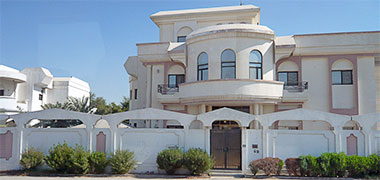
In Qatar there is still the tendency to use solid walls at the fronts of properties in order to provide visual security to the occupants. One of the results of this is the preponderance of hard surfaces viewed in the urban environment. While planting within properties is often visible and can be used to soften the views in terms of colour, movement and, perhaps, scent, there is still the possibility to plant outside many private residences. Here an owner has begun to plant what appears to be casuarinaoutside his wall. Eventually this will form a complete barrier. It may not be the best thought out solution, but it is a step in the right direction.

As might be expected, some parts of the private sector are responding to the perceived or actual wishes of residents by designing housing which would be more familiar to expatriates while maintaining something of the restrictive character of Qatari housing, both traditional and new. Here an up-market private development has been designed with a relatively closed face to the street, but with the incorporation of non-indigenous planting both as specimens as well as a peripheral element. In this case, the front hedge incorporates a steel fence for added security, a sensible precaution, though one that makes its maintenance problematic. The effect, though, is to create a softening of the orthogonal architecture while going a little way to improving the micro-climate created by the housing and its paving.
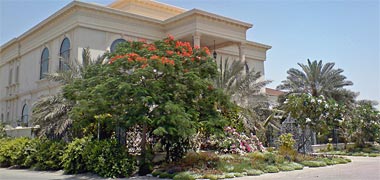
By comparison with the above two photographs, this photograph illustrates how the dissolving of the front of a property might be carried out. The photograph is of a house in Bahrein but conceptually the property is very similar to many in Qatar. Here the front wall has been replaced by a transparent steel fence which allows some security while permitting views back to the house. Security, to a small degree, is also reinforced by the planting. But the main point here is that the front of the property has been softened by the planting, the public area extended into the face of the house while, conversely, the residents of the house have had their property visually enlarged into the public domain – albeit with the loss of some privacy. It is also worth noting the care which has gone into plant selection in terms of plant massing and colour. The under-planting leads naturally into the fence cover while the different, local trees provide shade and movement. Altogether it is a very successful essay into the integration of public and private landscaping, to the benefit of the neighbourhood.
One important point to make here is that the more planting there is in the cul-de-sac and adjacent gardens, the more beneficial this will be in creating a pleasant micro-climate.
With regard to the public space there are a number of different ways of treating it from a landscaping point of view. Here I have set out some crude alternatives, all based on there being a peripheral service road or pavement, and dealing only with the soft landscaping. The aim is solely to show illustrative types of solution though they will all depend on State funding and policies with regard to semi-public development. It might even be that the residents of a cul-de-sac would fund installation and upkeep themselves, though I know from discussions that it is thought by them that the State should provide for both installation and maintenance.
A second issue is that of plant type. There is a strong body of opinion in the State that the only plants that should be used in public spaces are those that are native to the region. Unfortunately this has proved difficult to define as plants have been imported from all over the world for a number of years.
A third issue should be noted and can be seen in the plan illustration below. There I have allowed a notional ten car spaces on the illustration for cars parking within the cul-de-sac. With each plot having sufficient space for its owner’s cars to be brought onto the plot, it is only guests who might need to be catered for in the public areas of the cul-de-sac. However, depending upon the people living on the cul-de-sac, there can be a widely varying number and character of vehicles that might need catering for at any one time, most notably for guests to a majlis.
The tendency is for vehicles to be parked extremely loosely, and for them to come and go on a random basis. Experience shows that whatever space is needed for parking is taken up rapidly, and then parking spreads to the more public areas outside the cul-de-sac. Where there is little or no landscaping in the cul-de-sac, then of course more cars can plant there. Peripheral parking along service road kerbs can be effective but there appears to be a resistance to this as, I have been told, it can be considered to be a security issue by both drivers and residents.
Whatever the issues are, there is a strong need for parking near properties, particularly when there is significant social connection necessitating visitors coming on a regular basis. Where a mosque is located near to a cul-de-sac, or to any group of house plots – and, as a rule of thumb I would suggest about one mosque to between sixty to eighty house plots – then it is likely that vehicles will park there and drivers will pray and then walk to a majlis.
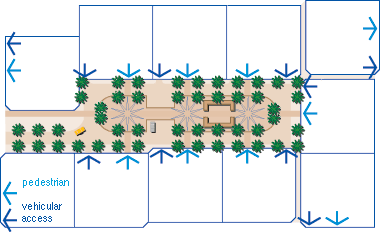
This first illustration shows planting intended to give the impression of a date palm farm, the palms being set out at regular intervals of about eight metres. This would give five palms across the cul-de-sac as well a five across the frontage of a thirty-five metre plot. Here I’ve arranged them as two pairs along the service road permitting an external majlis and pedestrian path to be located along the spine of the cul-de-sac. Planting adjacent to property boundary walls would preclude the adjacent use of a pedestrian path unless design provision is made for pedestrians. In fact, this would be a useful way of slowing traffic and breaking down the scale of the service roads within the cul-de-sac. Washingtonia could be used to give the same effect.

This first drawing is a sketch of a notional modern internal majlis illustrating something of the character of the layout as well as of classic Western style furniture with their simple lines. The intention of using it here is as a reminder of what might be looked for in an external majlis. The seating plan is always peripheral and, although it is unusual to have tables provided outside, they are often carried out along with elements such as televisions and radios for the evening, and taken in again later.
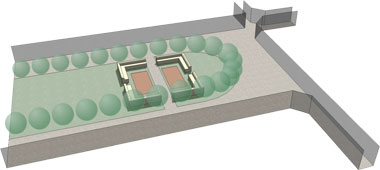
This illustration is a reflection of the internal majlis, and is based on the sketch plans above but shows a lower planting mass rather than date palms in order to be able to contain the majlis area in the form of a dikka in the centre with a pair of kilim, an arrangement which is often used in this context. It’s not unusual to see in similar circumstances a television located there – an accurate replication of what happens in an internal majlis or even outside houses where there may be an informal majlis operating in the evenings.
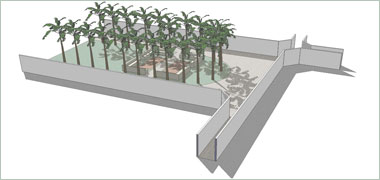
This second illustration gives a view of the same area with peripheral palm trees but with the external row omitted. Even with this omission you can see how the character of the internal area is very different. I should add that external majaalis located under trees are a very popular setting and one of the features loved by those who are lucky enough to own farms.
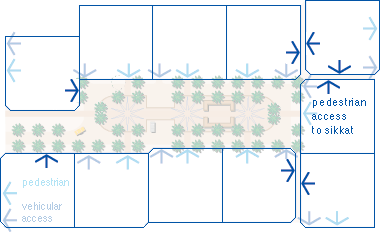
This diagram illustrates the relationship of additional accesses to the sikkak as well as the culs-de-sac themselves. The importance of this has been described elsewhere. It gives additional privacy for family, friends and servants to move around the system as well as encouraging the use of spaces – the sikkak – that have additional environmental benefits due to their cross section and potential for shade from adjacent gardens. Contrary to Western belief, such openings are liked by locals and are widely used when available.
One advantage to having a layout using trees with high canopies is that it plays down the visual canyon effect of the service road within the cul-de-sac. In the top illustration the service road is likely to be given undue prominence by the selection of planting.
Whereas, in the lower illustration, the overall treatment with a forest of palm trees creates a roof to the external space. This effect shouldn’t be under-estimated. Daytime and, particularly, evenings are really pleasant spent under a canopy of palm trees. It is one of the features that those lucky enough to own farms in the country really enjoy.
If trees or shrubs with lower foliage are located in the public area, they will inhibit the number of activities that can be located there as well as focussing more attention on the roads. Of course, with all these illustrations, there is no need for the whole of the width to be taken up with planting, nor the length.
Planting can be mixed. Here I’ve suggested a mix of date palms or Washingtonia on the periphery, with low level planting and Mediterranean cypress – cupressus sempervirens – on the inside, though I have to admit that I don’t know if that particular tree would flourish in Qatar.
A lot of the early tree planting in Qatar was of ficus nitida. On some specimens there were attempts at topiary and here I’ve suggested a formal topiary arrangement utilising ficus nitida as a way of enclosing the central area. Of course, planting grows and, with time, there will be a strong sense of enclosure from such an arrangement leading from what would essentially be a hedge to something on a much larger scale, dominating the cul-de-sac.
And there is always the possibility of an asymmetrical planting design. Generally speaking this is unlikely as there is a very strong tradition of having planting – both soft and hard – arranged within a strong geometrical arrangement describing the landscaped area.
This point is important. If I’ve not mentioned it elsewhere, there is the feeling that it is the designer who creates order out of chaos or, perhaps, better stated as it being the designer creating a landscaping pattern that is defined by geometry. I have written elsewhere that there are three forms of Islamic decorative design – geometric, floral and calligraphic. Landscape design is ideally suited to combine at least the first two elements. Certainly, a strong geometric plan itself is enough to gain the approval for a design, even though the design on the ground may not be immediately identifiable as such to the user. On the other hand I have seen designs instantly rejected on the basis that their geometry was based on Stars of David, or on Ley Lines – the latter, for those who have not come across them, are lines of magnetic force experienced by those sensitised to identify them; drawn on a plan, they present an extremely irregular arrangement with no organised geometry controlling them.
Perhaps greater than the sense of openness in width, culs-de-sac may be seen to be extremely long, not dissimilar from the effect of straight roads. This would produce the unfortunate, estate-like effects seen in some of the public housing areas on the outskirts of Doha and elsewhere. This should be resisted in order to contain the public spaces related to the housing and to reinforce the sense of community and discrete identity that is generally sought by residents.
Developing a number of recreational and other functions within the culs-de-sac can break down any lineal effect and, in addition to any spatial development related to, or created by, constructional development, this can be reinforced by the introduction of planting in lateral bands to create transverse interventions in the lineal space created by the proportions of the culs-de-sac.
Location of houses on their plots
My preference is for houses to be located on plot boundaries in order to give an optimal amount of the site over to external use by the family living in it. However, as is described elsewhere, decisions were taken by government to locate houses in both the Public housing and Senior Staff housing at the centre of each plot.
It is commonly thought that there can be little variety when houses are situated on boundary walls. To demonstrate the possibilities I thought it might be useful to show the theoretical number of ways in which edge-located houses could be put together. Obviously there are some conditions which would not work as well as others.
At its simplest there are the possibilities of having twelve different arrangements where a plot at the end of a cul-de-sac has three sites adjacent to it – within that cul-de-sac. For the sake of the basic mathematics, this ignores:
- the adjacent pedestrian passages which effectively create a break between the main property and its two adjacent properties within the cul-de-sac, and
- the properties related to any adjacent culs-de-sac and that would be behind the main plot.
It is also notable that, in these arrangements, houses are built at right angles, a policy in conflict with that regarding the optimal orientation of houses as having their long sides on an east-west axis.
Basic adjacencies
Adjacent to any single site there are likely to be up to five other sites depending upon whether the site is located
- in the middle of a run of plots with other plots backing onto them, or
- at the end of a cul-de-sac with no development to its rear.
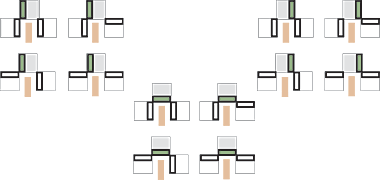
This diagram illustrates the twelve combinations for the three sites adjacent to a plot at the head of a cul-de-sac where buildings physically touch neighbours though, as described above and for the sake of the maths, I’m ignoring the passageways which move boundary walls away from each other as well as any properties relating to any other adjacent culs-de-sac. So, this gives us 3.2.2 or 12 possible combinations, though there would only be 4 combinations where the central house is touching both adjacent houses.
Note that, for the purpose of these illustrations, I’m drawing the sites with a notional north at the top of the culs-de-sac. Orientation and the position of the house on its plot will be reflected in the treatment given to the façade of each house to deal with environmental controls. Consequently there is bound to be theoretical differences in treatment when sites and their buildings are reflected.
More complex adjacencies
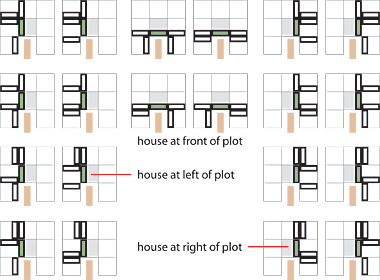
Where a house has neighbouring sites with contiguous houses both at its sides and behind it there are obviously 2.2.2.2 + 2.2 or 20 theoretically possible combinations for the houses on their sites if it is assumed that there are only three possible locations for each house on its site: along the front boundary, and along each of the side boundaries. Developing along the rear boundary is not recommended as it does not lead to easy private planning of the site although it would, of course, be possible to create privacy with the use of visual walls or barriers.

This number of combinations also assumes that the houses are not orientated in a single direction. If they were to be so – in the east-west direction of their long access to reduce solar gain – then the possible combinations would be reduced to a single 1 if the cul-de-sac is oriented north-south and 2 if the cul-de-sac is oriented east-west with no house behind it. These numbers would obviously be doubled if the situation is mirrored in the north-south directions for the example on the left and the east-west direction for that on the right.

If the adjacent sites were to be developed with the house on the rear wall of the property, then there would be 2.3.2.2.2 or 48 possible combinations for the central house to have contiguous houses on the five adjoining plots. Here are ten of the alternatives illustrated, along with the manner in which the combinations are calculated.

Where the relationships created in the development of any plot have contiguity with the central site, that would add to the combinations a further degree of complexity – 2.3.2.3.3.2.2, or 432 possible combinations. Though where the house at the rear of the central property is on a run of houses with a row backing onto it, and not at the end of a cul-de-sac, then there would be only 2.3.2.3.3, or 108 combinations.
The purpose of looking at these numbers is solely to give an indication of the variety that can be achieved independent of any architectural treatments that will be needed to deal with both the security aspects of the contiguous developments and the need that all buildings have for environmental considerations.
Combinations
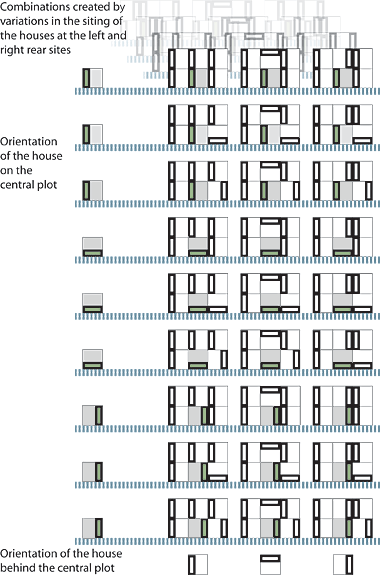
It has to be remembered that although this is a mathematical exercise many of the combinations will work well in practice. Such combinations might not be liked as there is a resistance by Qataris to having their houses touching their neighbours, for instance, although this was often a feature of traditional housing. However, there are significant advantages to having houses adjoin each other, assuming that privacy and security can be readily incorporated within their designs.
In addition there are some combinations where the orientation of some of the houses has little impact upon the central plot. An example of this would be where there is no contiguity between houses on adjacent sites with that on the central plot.
The calculations for combinations really demonstrate only the variety of arrangements possible with a simple geometry. Obviously variations to the lot geometry in size, shape or the staggering of lots will greatly increase the opportunities for designers.
Finally it should be borne in mind that there may be significant advantages from combining site arrangements in this manner, though it is my feeling that developing along the front boundary will give optimal benefits to housing sites.
A new approach – conceptual | top | A new approach – details
Search the Islamic design study pages
- Introduction
- Arabic / Islamic design
- Arabic / Islamic geometry 01
- Arabic / Islamic geometry 02
- Arabic / Islamic geometry 03
- Arabic / Islamic geometry 04
- Islamic architecture
- Islamic urban design 01
- Islamic urban design 02
- Islamic urban design 03
- Islamic urban design 04
- Islamic urban design 05
- Arabic / Islamic gardens
- Gulf architecture 01
- Gulf architecture 02
- Gulf architecture 03
- Gulf architecture 04
- Gulf architecture 05
- Gulf architecture 06
- Gulf architecture 07
- Gulf architecture 08
- Infrastructure development
- The building industry
- Environmental control
- Perception
- The household on its lot
- A new approach – conceptual
- A new approach – principles
- A new approach – details
- Al Salata al jadida
- Public housing
- Expatriate housing study
- Apartment housing
- Pressures for change
- The State’s administration
- Society 01
- Society 02
- Society 03
- Society 04
- Society 05
- Society 06
- History of the peninsula
- Geography
- Planning 01
- Planning 02
- Population
- Traditional boats
- Boat types
- Old Qatar 01
- Old Qatar 02
- Security
- Protection
- Design brief
- Design elements
- Building regulations
- Glossary
- Glossary addendum
- References
- References addendum
- Links to other sites